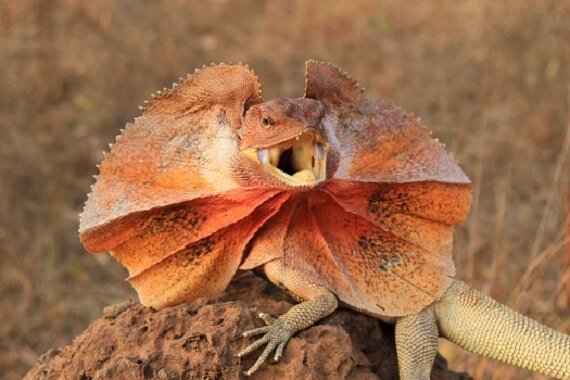
In this exploration, I’ll break down the key areas where frilled lizards live, the conditions that suit them best, and how their behaviors adapt to their surroundings. So, grab a cup of coffee, and let’s jump into the world of frilled lizards!
1. The Natural Habitat of Frilled Lizards
Frilled lizards primarily inhabit humid forests and woodlands. They thrive in environments with plenty of trees and bushes, which provide both shelter and hunting grounds. These lizards are semi-arboreal, meaning they spend a lot of time in trees. You can find them basking on branches or lurking in the foliage, ready to pounce on unsuspecting insects.
The lush greenery of their habitat is crucial. Frilled lizards are camouflaged by the trees, making it easier for them to ambush prey and evade predators. Think of it as a natural game of hide-and-seek, where the trees are both a stage and a shield.
2. Geographical Distribution
When it comes to geographical distribution, frilled lizards are found in specific regions primarily across northern Australia and parts of New Guinea. In Australia, they’re often spotted in the northeastern areas, particularly in Queensland and parts of the Northern Territory.
The frilled lizard’s range mostly overlaps with tropical and subtropical climates. This means they enjoy warm temperatures and high humidity, typical of rainforest edges and open woodlands. So, if you’re planning a trip to these regions, keep your eyes peeled—they might be watching you!
3. Climate Preferences
Frilled lizards thrive in a climate that’s warm and humid. They tend to avoid overly dry or cold environments. This preference is pretty practical; they rely on warmth for their metabolism and humidity to help with hydration.
Typically, they become more active during the rainy season, which provides more food options and better living conditions. Imagine how they might feel when a rain shower spills across the forest—everything gets a little more vibrant and alive, just like they prefer it.
4. What They Eat: How Habitat Affects Diet
Their habitat plays a significant role in their diet. Frilled lizards primarily feast on small insects, such as crickets, beetles, and ants. With access to dense vegetation, they can easily hunt for their next meal. They rely on their keen eyesight to spot movement among the leaves.
It’s fascinating to think about the entire ecosystem at play here. The presence of frilled lizards can help control insect populations, making their habitat a balanced environment. When they’re full and happy, the ecosystem thrives, all thanks to their natural hunting skills.
5. The Importance of Protection in Their Habitat
In their natural habitat, frilled lizards face threats from predators like birds of prey and snakes. To survive, they’ve developed some clever strategies. When frightened, they can display their frills, which makes them look larger and more intimidating. This is nature’s way of providing them with a chance to escape.
Additionally, their ability to blend in with their surroundings is crucial for their protection. Their color patterns mimic the bark and leaves of their habitat, making it harder for predators to spot them. It’s like they have a built-in camouflage, allowing them to live a life of stealth and survival.
6. Human Impact on Their Habitat
Unfortunately, human activities have affected the habitats of frilled lizards. Deforestation, agriculture, and urban development can reduce the lush environments they rely on. When their homes shrink, it can lead to increased competition for food and higher risks of predation.
Conservation efforts are essential to ensure these unique creatures continue to thrive. By safeguarding their habitats, we can help maintain the balance of wildlife in the regions they inhabit. It’s a simple reminder that everything in nature is interconnected.
7. How Frilled Lizards Adapt to Their Environments
Frilled lizards are truly adaptable. They can modify their behavior based on the conditions around them. For example, during hot days, they often bask in the sun to raise their body temperature, while in cooler weather, they seek the comfort of shade or shelter provided by leaves and branches.
This adaptability isn’t just about survival; it’s also about thriving within their space. They make the most out of their surroundings, learning the best places to find food and avoid danger. It’s a survival strategy that keeps them one step ahead in the wild.
8. Conclusion: The Future of Frilled Lizards
In summary, the frilled lizard’s habitat is a delicate balance of warm climates, dense vegetation, and ample food sources. Their distribution across northern Australia and parts of New Guinea highlights their need for specific environmental conditions. Unfortunately, the impact of human activities poses a threat to their populations.
By understanding where frilled lizards live and the challenges they face, we can better appreciate the importance of preserving their habitats. After all, every little action counts when it comes to protecting these remarkable creatures.
So, next time you hear about frilled lizards, you’ll know they’re not just bizarre-looking reptiles but vital players in their ecosystem, adapting and surviving in a world that’s changing fast. Let’s do our part to ensure they continue to flourish in their natural homes for generations to come!
